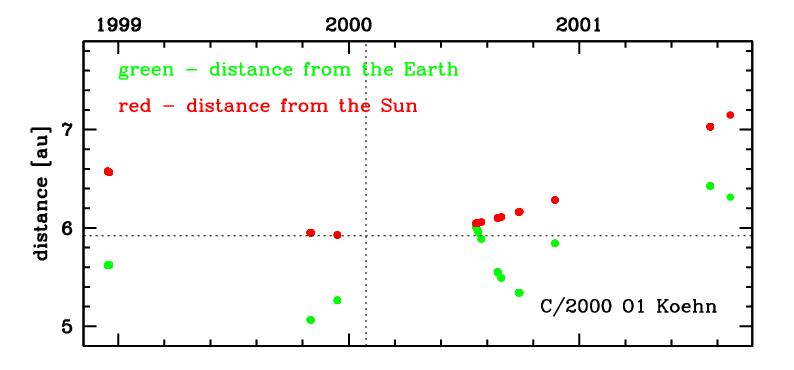C/2000 O1 Koehn
more info
C/2000 O1 was discovered on 26 May 2000 by B.W. Koehn in the course of the LONEOS as a cometary object [IAUC 7462, 2000 July 23]. Positional observations of this comet were next linked by Brian G. Marsden with pre-discovery measurements of two asteroidal objects observed by LINEAR (1998 XA70 = 1999 UJ10) going back to 14 December 1998 [MPEC 2000-O22].
This comet made its closest approach to the Earth on 9 November 1999 (5.050 au), 2.5 months before perihelion.
Solution given here is based on data spanning over 2.7 yr in a range of heliocentric distances: 6.58 au – 5.922 au (perihelion) – 7.15 au.
This Oort spike comet suffers small planetary perturbations during its passage through the planetary system that lead to a more tight future orbit (see future barycentric orbit).
See also Królikowska 2014 and Królikowska and Dybczyński 2017.
This comet made its closest approach to the Earth on 9 November 1999 (5.050 au), 2.5 months before perihelion.
Solution given here is based on data spanning over 2.7 yr in a range of heliocentric distances: 6.58 au – 5.922 au (perihelion) – 7.15 au.
This Oort spike comet suffers small planetary perturbations during its passage through the planetary system that lead to a more tight future orbit (see future barycentric orbit).
See also Królikowska 2014 and Królikowska and Dybczyński 2017.
| solution description | ||
|---|---|---|
| number of observations | 65 | |
| data interval | 1998 12 14 – 2001 08 27 | |
| data type | perihelion within the observation arc (FULL) | |
| data arc selection | entire data set (STD) | |
| range of heliocentric distances | 6.58 au – 5.92 au (perihelion) – 7.15 au | |
| detectability of NG effects in the comet's motion | NG effects not determinable | |
| type of model of motion | GR - gravitational orbit | |
| data weighting | YES | |
| number of residuals | 128 | |
| RMS [arcseconds] | 0.81 | |
| orbit quality class | 1a | |
| orbital elements (heliocentric ecliptic J2000) | ||
|---|---|---|
| Epoch | 2000 01 17 | |
| perihelion date | 2000 01 27.39323200 | ± 0.00340200 |
| perihelion distance [au] | 5.92165320 | ± 0.00002637 |
| eccentricity | 1.00069750 | ± 0.00002806 |
| argument of perihelion [°] | 55.112765 | ± 0.000318 |
| ascending node [°] | 88.862048 | ± 0.000114 |
| inclination [°] | 148.097534 | ± 0.000041 |
| reciprocal semi-major axis [10-6 au-1] | -117.79 | ± 4.74 |
